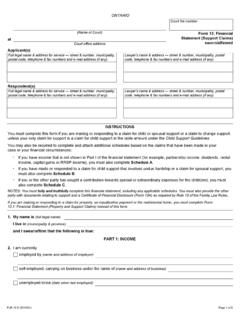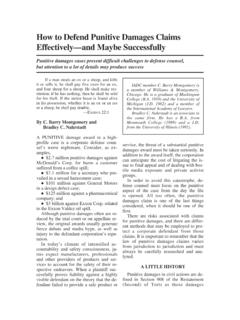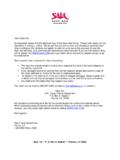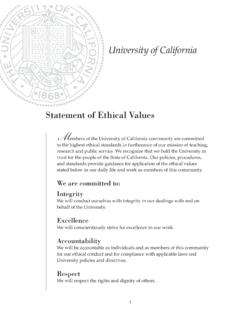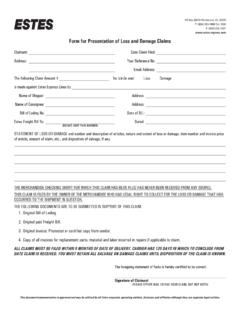Transcription of The Introduction of Negative Claim Limitations During Ex ...
1 The Introduction of Negative Claim Limitations During Ex Parte Prosecution: 35 112 and the Issue of Antecedent support Steven J. Hultquist Frequently, in the course of prosecuting patent applications, the patent solicitor, in the effort to patentably distinguish claims over prior art, gives consideration to inclusion in the claims of Negative Limitations . Such Limitations , by expressly excluding from the scope of the claimed invention features which are taught or suggested by the prior art, provide a potentially effective means for the patent solicitor to overcome prior art rejections of anticipation and obviousness, with the appertaining argument for patentability over the prior art that "they have [or suggest].
2 It, we exclude it.". Alternatively, a Patent and Trademark Office (PTO) Examiner, seeking to expedite the disposition of a patent application, may suggest the inclusion of Negative Limitations in claims under examination for the same reason, viz., that such Negative Limitations clearly and effectively distinguish the applicant's invention, and thus provide the Examiner with the basis for a cogent explanation of patentability in his or her statement of the reasons for allowance. This article examines some of the problems which arise in the practice of introducing Negative Claim Limitations During the prosecution of patent applications, in the context of PTO acceptance and case law treatment of Negative Claim Limitations .
3 The article then focuses on anomalies in Negative Claim limitation practice, relative to (i). prosecution practice involving "open ended" and "closed ended" Claim language, and (ii). Markush claiming practice. A common sense synthesis of the conflicting considerations and approaches is considered, and a suggested approach is advanced for determining when and to what extent Negative Claim Limitations should be permissible and properly employed. I. Definition and Utility of Negative Claim Limitations As used herein, the term " Negative limitation" refers to a Claim recitation which specifically excepts a particular element, composition, structure, sub-assembly, step, or other feature from the claimed invention.
4 Illustrative examples of Negative Limitations include the following: ..in the absence of an accelerator curingly effective for said ;..devoid of any edge surface protrusions..;..without annealing said alloy prior to said passivation treatment thereof ;..said laminated web not including any embossments on marginal portions thereof . It is readily apparent that Negative Limitations can provide a satisfactory terminology for effectively distinguishing claimed inventions from prior art, in a manner which is very specific to the prior art and thus does not otherwise excessively narrow the scope of protection obtainable on the invention.
5 Taking as an illustrative example the aforementioned recitation .."devoid of any edge surface protrusions.. thereon," it is possible to differentiate the claimed invention from prior art structures characterized by edge surface protrusion elements, while at the same time leaving the Claim open to coverage of other edge surface geometries, , concavely dimpled edge surfaces, which would otherwise be outside the literal scope of the Claim , if a positive limitation such as ".. having smooth edge surface portions " were instead employed. II. Pre-Filing Incorporation of Antecedent Specification Basis for Negative Claim Limitations vs.
6 Introduction Thereof During Ex Parte Prosecution Without Antecedent Specification Basis: Problems and Tactics It is a fundamental requirement of Claim drafting practice that the claims of a patent (application) must be consistent with and supported by the specification, in order to comply with the requirements of 35 112, with regard to the so-called "enabling disclosure" and "particular pointing out and distinctly claiming" provisions of the statute. In the circumstances where the patent solicitor is knowledgeable of pertinent art and drafts the patent specification to provide express support for a potentially distinguishing Negative limitation, , so that the specification contains an explicit statement of the Negative limitation, then there is a direct antecedent support in the specification for appertaining Negative limitation Claim terminology.
7 In many instances, however, the patent solicitor first becomes aware of prior art which is distinguishable via Negative Claim Limitations , During the course of prosecution, after the patent application has been filed, and without any express statement of the Negative limitation in the as-filed specification. Under such circumstances, the patent solicitor is faced with a conflict. If he or she introduces a Negative Claim limitation, the same may be operative on its face to clearly distinguish the claimed in- vention from the otherwise problematic prior art, but the Examiner may take the position that such Negative Claim limitation is not sup- ported by a corresponding explicit statement of the Negative limitation in the specification and thus constitutes "new matter" under 35 132.
8 At this point, the patent solicitor typically is reduced to arguing that such Negative limitation is implicit in the disclosure (adopting an "inherency" hypothesis), or else refiling the patent application, , as a continuation-in-part (CIP), to expressly set forth in the specification the Negative limitation sought to be included in the claims. Both of these courses are fraught with potential risks. In the former case, the Examiner may remain unpersuaded that the Negative limitation sought to be introduced into the Claim (s) is adequately supported in the specification in compliance with 112 and 132.
9 Requirements. In the latter case, there is, in the act of refiling to include the express statement of the Negative limitation to the specification, a tacit admission that the Negative limitation is not "inherent" in the originally filed disclosure, and the accompanying risk that intervening prior art or "statutory bar" events may come into play. Although the applicant may, consistent with the position that the Negative limitation is inherent in the prior disclosure, file a "continuation" application as opposed to a CIP, and identify the purpose of the continuation as "merely making express what is implicit in and intrinsic to the prior disclosure," the effect of such action, even if successful in the Patent and Trademark Office, may be nullified in subsequent litigation by a finding that the Negative limitation was in fact "added" and not "inherent.
10 ". On balance, if refiling is resorted to, it would appear to be the better strategy to denominate the refiled application containing the express statement of Negative limitation as a "continuation" and to make the appertaining inherency argument, if this is in fact a reasonable and tenable position. III. PTO Acceptance and Case Law Treatment of Negative Claim Limitations The reported cases which have construed the validity of claims in which a Negative limitation was introduced During prosecution of a patent application are comparatively few in number and not at all coherent, insofar as the ability to extract a bright line demarcation of the law from them is concerned.
